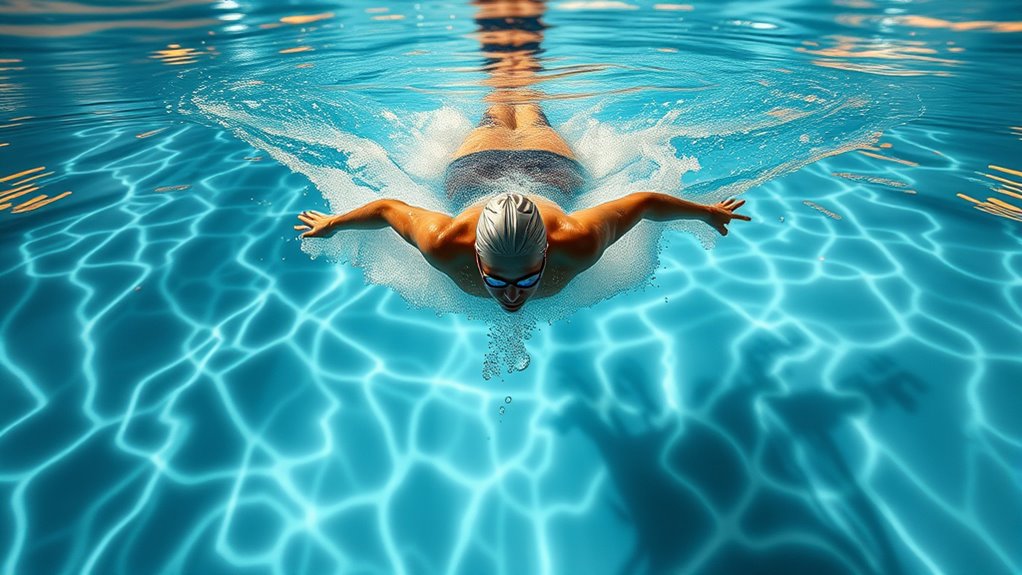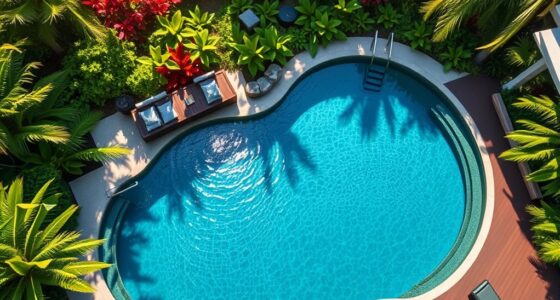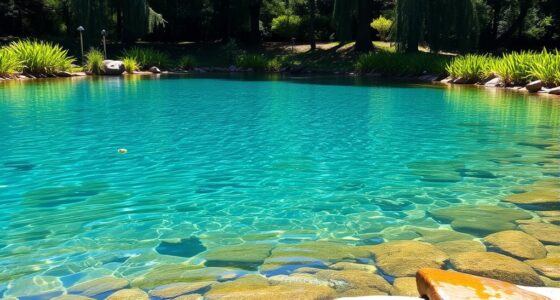Swim-in-place systems use controlled water flows called counter-currents to mimic open water swimming. A pump or jet creates a steady, adjustable current that you can swim against or with, giving you resistance and a natural feel. This hydrodynamic principle allows you to perform various strokes or running motions in a compact space. If you’re curious about how these water flows are precisely managed and optimized, there’s more to uncover below.
Key Takeaways
- Counter-currents generate a controlled water flow by using pumps or jets to mimic open water swimming conditions.
- They create a steady, adjustable current that provides resistance for continuous aquatic exercise.
- The water movement is designed based on hydrodynamic principles to optimize flow and user experience.
- Swimmers can perform various strokes or running motions against the current, enhancing versatility.
- This technology allows effective, space-efficient aquatic workouts without the need for large pools.

Swim-in-place technologies are revolutionizing water-based exercise by allowing users to enjoy the benefits of swimming without the need for a large pool or extensive space. These systems use the principles of hydrodynamics to create a counter-current that mimics natural swimming conditions. By understanding hydrodynamic principles, you can grasp how these devices generate a steady flow of water, enabling you to perform aquatic exercise in a confined area. The core idea behind these technologies is to manipulate water flow to create resistance similar to that experienced in real swimming. The device typically employs a powerful pump or jet system that circulates water in a controlled manner, establishing a uniform, adjustable current. As you position yourself in the water, you face this current, which provides resistance for your workout. The flow’s strength can be customized, allowing you to increase or decrease intensity based on your fitness level or training goals. This setup embodies the hydrodynamic principles of fluid resistance and flow dynamics, making your aquatic exercise more effective and engaging.
Revolutionizing water exercise with hydrodynamics: enjoy a natural swim experience in a compact space.
Because of their design, swim-in-place systems allow for continuous, low-impact cardiovascular workouts that are gentle on your joints while still challenging your muscles. You can simulate different strokes or running motions, giving you flexibility in your training routines. The resistance you experience pushes your muscles to work harder without the strain that high-impact activities might cause. Plus, since the water’s flow is consistent and controllable, you can maintain a steady pace, track your progress, and even incorporate interval training.
Another advantage of these technologies is their space efficiency. You don’t need a large pool or complex infrastructure—just a small, dedicated area where the system is installed. The water circulation creates an environment that closely resembles open water, making your aquatic exercise feel natural and immersive. Additionally, because you’re working against a consistent current, you can improve your stamina, technique, and overall fitness from the comfort of your home or gym.
Furthermore, knowledge of training tools and proper techniques can enhance the effectiveness of your workouts with swim-in-place systems. In essence, swim-in-place technologies harness hydrodynamic principles to transform a compact space into a versatile aquatic training zone. By generating controlled counter-currents, they enable you to perform effective aquatic exercise that’s adaptable, low-impact, and highly efficient. Whether you’re training for competition, rehabbing injuries, or simply seeking a new way to stay fit, these systems provide a practical solution that leverages the science of water flow for ideal results.
Frequently Asked Questions
How Energy-Efficient Are Swim-In-Place Systems Compared to Traditional Pools?
You’ll find that swim-in-place systems are more energy-efficient than traditional pools, offering significant energy savings. They use less water and require fewer chemicals, reducing environmental impact. By recycling water and maintaining consistent conditions, these systems cut down on energy consumption for filtration and heating. Overall, they’re a smarter, eco-friendlier choice that helps you enjoy your swim while being gentle on the environment.
Can Swim-In-Place Devices Simulate Different Water Currents?
You can definitely experience different water currents with swim-in-place devices. They utilize advanced mechanisms to mimic water flow variability, giving you the sensation of swimming through various currents. While the current simulation accuracy varies between models, many systems now offer adjustable settings that replicate gentle flows or strong currents. This allows you to customize your workout, making your swim feel more dynamic and engaging, just like real open water conditions.
Are There Safety Concerns With Long-Term Use of These Technologies?
Long-term use of swim-in-place technologies can pose health risks and potential long-term effects if you’re not careful. You might experience muscle strain, joint stress, or fatigue from repetitive motion or improper technique. Over time, inadequate rest or poor hydration could lead to more serious issues like overuse injuries. To stay safe, it is crucial to listen to your body, use proper form, and consult with a healthcare professional if you notice discomfort or persistent pain.
How Customizable Are the Resistance Levels in Swim-In-Place Systems?
You can customize the resistance levels in swim-in-place systems easily, thanks to their variable resistance features. Most models allow you to adjust the resistance to suit your workout needs, giving you full control over your exercise intensity. This user customization guarantees you can progress gradually or target specific muscle groups, making your swimming workouts more effective and tailored to your fitness level.
What Maintenance Is Required for Optimal Performance of These Devices?
Think of your swim-in-place device as a thriving garden that needs regular tending. To keep it blooming, you should follow consistent cleaning routines to prevent buildup and inspect hardware for wear or loose parts. Lubricate moving components as needed, and check resistance settings for accuracy. By staying proactive with maintenance, you ensure smooth counter-current flow and extend your system’s lifespan, making every swim feel like a invigorating dip in pristine waters.
Conclusion
As you embrace swim-in-place tech, remember the timeless dance of Poseidon’s currents—balancing power and grace. These innovations harness nature’s own rhythm, allowing you to glide effortlessly without leaving your space. Just like the mythic sea god’s mastery over waters, you gain control over your aquatic workouts, turning the pool into your personal ocean. With each stroke, you connect to something greater, echoing the eternal flow of currents that shape both myth and machine.









